In the past five years we’ve seen major technological advances in both shoe construction and materials, creating an enormous variety for runners to choose from no matter their level. But as more companies turn to e-commerce platforms rather than brick and mortar stores, the days of in-person consultations are quickly fading. Here’s what you need to know about the latest shoe technology so that you can choose a pair that’s right for you.
Lighter Foam = Faster Running
“The primary thing that has happened is the creation of new foams that can provide more energy return and are lighter. Couple that with stabilizing elements in the midsole like a carbon plate that can direct the energy of the foam, and you can run faster with less cost — which is why world records are being beaten over the past 3-4 years,” explains Jacob Brady, a running shoe tester for Road Trail Run who recently marked a three year run streak of his own.
Brady has tested 54 pairs of shoes so far and keeps detailed records and observations. “It used to be that elites would race in low stack, firm shoes and now there is a massive stack. No one considered that model when the foam was heavier and there wasn’t an understanding about the propulsive effect of the midsole.” Stack height refers to how much shoe material exists between your foot and the ground. The trend, therefore, is a bigger stack made with lighter foam.
“There are the super shoes with the high stack and carbon plates, but there are also super foams that function as their own thing,” says Brady. The foam is light and responsive with a high rebound. It cushions the foot but also springs back into shape. “One example of foam that stands alone is Nike ZoomX, the flagship foam that’s lightweight with high rebound and found in a lot of their shoes, including the new Nike ZoomX Invincible Run,” he says. Nike describes the shoe as “lightweight and responsive foam [that] delivers a super-soft feel and helps deliver energy with every step.”
A 2020 commentary in Footwear Science that explored the effects of running shoe construction concurred that construction could have large impacts on performance. “A change in shoe mass of 100g corresponds to a change in oxygen consumption of about 1%.” That means that less weight lets you run more efficiently — more speed at a lower metabolic cost—which explains why newer foams are getting lighter and lighter.
Propulsion From Carbon Plates
The biggest impact on running performance, however, comes from a shoe’s longitudinal bending stiffness, which refers to how hard it is to fold the shoe toe to heel. A soft shoe can easily be bent, whereas a shoe made with a stiff sole and a midsole plate will hardly bend at all.
The scientists in the Footwear Science article, who have tested shoes for many of the large footwear companies, referred to this construction as having a “teeter-totter effect”. Picture a teeter-totter or seesaw: while one person pushes their weight down, the other end goes up. Essentially, the same thing happens with a carbon plate; and the larger the shoe’s stack height, the more curved the plate can be.
“If the curvature of the plate is designed correctly, the teeter-totter effect will result in a force acting on the heel driving push-off that acts at the right location (at the heel of the foot), at the right time (during take-off), and with the right frequency,” the article states. The result substantially contributes to running economy, which the researchers suggest could potentially be improved by up to 6%.
Can New Technologies Prevent Injury?
It warrants noting that these new technologies don’t necessarily prevent injury. An October 2020 research article in the Journal of Athletic Training sought to ascertain the role running footwear might play in injury risk using only evidence-based data — and the evidence is far from conclusive. Footwear characteristics that have been studied include heel-to-toe drop, midsole thickness, minimalist index, innersole thickness, mass, midsole hardness, stability elements, shoe age, and usage. The problem with trying to connect any specific variable to injury is that every runner is different.
Overuse injuries in runners, in fact, often result from an imbalance between training load and the body’s ability to adapt and regenerate. Building too fast, or even taking on a new shoe style without transitioning incrementally, could be more influential than shoe choice. In addition, making individual assessments about how a shoe fits and feels is essential.
But this doesn’t mean runners are left guessing entirely. Some general recommendations stand the test of time. These include subjective assessment — does the shoe fit well and feel good? Does your stride seem normal? One of the most tried and true bits of advice is to alternate between pairs of running shoes to avoid systematic overload and allow progressive transitioning to new shoes. By rotating different types of shoes, repetitive stress on the body can be reduced.
So, go ahead and explore the modern world of light and springy foams, carbon plates, and large stack height. Different runners will benefit from various styles. For example, many of the carbon-plated racing shoes help heel strikers lessen the impact on their joints and encourage their weight to shift forward. Choosing a light, resilient shoe isn’t just for racing — added to your quiver, they can enable you to increase overall mileage while staying fresh and strong.










